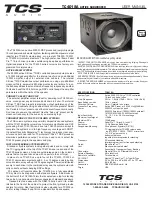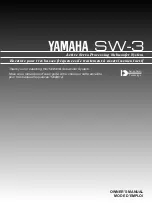
10
Subwoofer Collection
Power switch
This is the master power switch that turns on the AC power. It must be in the “on” position for the
subwoofer to function. If the power switch is on, the on/auto/off switch (see pg. 8 “off/Auto/On Switch”)
controls the subwoofer’s power.
AC cord input
This connector accepts a standard two-conductor AC power cord (included). Note that the jack is not
polarized, which means the connector can be reversed. Reversing the AC cord in this jack can sometimes
fix hum (grounding) problems in the audio system.
Subwoofer Placement
The more walls the subwoofer is near, the louder (and sometimes boomier) the bass will sound. If you
want maximum bass output, put the subwoofer in a corner. If this makes the bass too loud or boomy,
move the subwoofer out of the corner and closer to the center of the wall. Often, placing the subwoofer
near or between the main speakers helps the subwoofer blend better with the speakers, and gives the
best compromise between maximum output and smoothest sound. When you listen to evaluate different
subwoofer positions, always do it from the chair or couch where most of the listening will take place.
A simple trick used by many home theater enthusiasts is to place the subwoofer in the primary listening
chair, play some music with a melodic bass line (most pop and jazz recordings will work), and crawl
around with your head about a foot or two off the ground. Find the spot along the wall where the bass
sounds the smoothest and most even from note to note, and put the subwoofer there.
Subwoofer Adjustment
If the subwoofer is installed in a surround-sound system: Use the crossover frequency and level controls
in the receiver or surround processor, following the manufacturer’s instructions.
If the subwoofer is installed in a stereo system without a built-in subwoofer crossover: Set the
subwoofer’s crossover control to match the rated bass extension of the speakers as closely as possible—
e.g., if you’re using tower speakers with 40 Hz rated deep bass response, set the crossover control to 50
Hz.
If you’re not sure what the speakers’ bass rating is, start with this control set in the middle (about 100 Hz),
with the volume control set in the middle. Adjust the volume control until the bass level roughly matches
the level of the main speakers. If some bass notes seem to be too quiet, set the crossover control to a
higher frequency. If some bass notes seem too loud, set the crossover control to a lower frequency. Do all
of your listening tests from the chair or couch where most of the listening will take place.




































